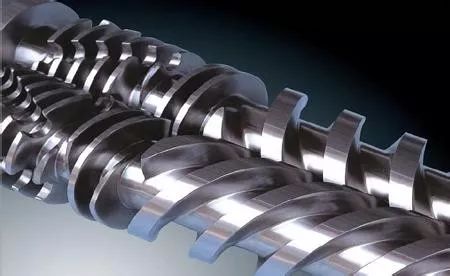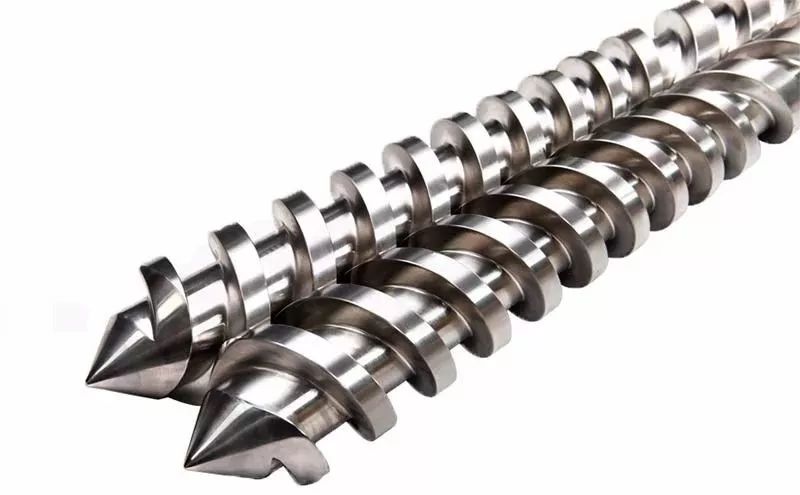In the PVC extrusion industry, screw breakage is a common issue that severely impacts production efficiency and product quality. Screw breakage is typically categorized into normal wear breakage and abnormal breakage. Below is an analysis of the causes of these two types of breakage and preventive measures:

1.Screw Processing and Materials
**Material Selection**
– Barrel Material: Commonly used materials include Cr12MoV (SKD61 alloy steel) and 38CrMoAlA.
– Screw Material: 38CrMoAlA is typically chosen.
**Heat Treatment Process**
– Barrel: Tempering is used to homogenize the internal structure and improve the metallurgical grade. Two-stage alloy steel parts undergo overall quenching, achieving a hardness of HRC60 after quenching.
– Screw: The final heat treatment is surface nitriding, with a nitriding depth of 0.5-0.7 mm. Large companies can achieve a nitriding depth of over 0.6 mm.
**Bimetal Processing Methods**
Metal processing methods generally include forging (for large parts) and casting (for small parts).
**Service Life**
The service life of the screw is related to the filler content:
– For ≤100 parts calcium: 1-2 years
– For 100-200 parts calcium: ~1 year
– For 200-300 parts calcium: 6-8 months
– For >300 parts calcium: 3 months
2.Influence of Screw Structural Characteristics on Pipe Processing and Mechanical Properties
**Requirements for Screw Structure Based on Filler Content**
– >120 parts: Smaller metering section gap, increased mixing grooves, and high-calcium screws.
– <80 parts: High-calcium screws with reduced feed and metering section flight gaps.
– <30 parts: Feed mixing section and compression section combined, with larger metering section flight gaps.
**Impact of Low-Filler and High-Filler Screw Structural Changes on Processing and Mechanical Properties**
Different formulations require different screws. The amount of lubricant affects plasticization and flow performance.
**Impact of High-Filler Production Formulations on Barrel, Screw, Material, and Heat Treatment Life**
High-filler formulations significantly increase wear on barrels and screws, reducing service life to typically 5-6 months.

3. Relationship Between Extruder Gearbox and Screw/Barrel Clearance
Clearance specifications for different models:
– 55/110: Axial clearance 1.5 mm, unilateral clearance 0.75 mm, front end 0.25 mm.
– 65/132: Axial clearance 2 mm, unilateral clearance 1 mm, front end 0.25 mm.
– 68/146.5: Axial clearance 2.5 mm, unilateral clearance 1.25 mm, front end 0.30 mm.
– 80/156: Axial clearance 3 mm, unilateral clearance 1.5 mm, front end 0.35 mm.
– 80/173: Axial clearance 3 mm, unilateral clearance 1.5 mm, front end 0.35 mm.
– 92/188: Axial clearance 2.8 mm, unilateral clearance 1.4 mm, front end 0.4 mm.
4.Relationship Between Barrel-Screw Clearance and Product
Processing/Plasticization
– Increased clearance: Higher backflow, poorer plasticization, increased screw wear, and shorter service life.
5.Analysis of Normal Wear Breakage and Abnormal Breakage of PVC Screws
**Normal Wear Breakage**
Screws are consumables during extrusion. Their lifespan is related to calcium powder content. Light calcium extends screw life compared to heavy calcium.
**Abnormal Breakage**
**Gearbox Bearing Damage**: Caused by aging or quality issues. Solution: Replace bearings.
**Insufficient Heating Temperature**: Due to wiring issues or damaged heating rings. Solution: Check wiring or replace heating rings.
**Material Interruption During Production**: Caused by bridging in the hopper or delayed feeding. Solution: Install a hopper agitator.
**Formula Error**: Caused by mistakes in ingredient mixing. Solution: Follow the formula strictly.
**Foreign Objects in Raw Materials**: Foreign objects causing screw jamming. Solution: Place strong magnets at the feed inlet.
6.Summary
Most screw breakages are caused by the reasons mentioned above. Regular inspection of the gearbox, ensuring adequate heating temperature, avoiding material interruptions, strictly following formulas, and preventing foreign objects in raw materials can effectively reduce the risk of screw breakage.
